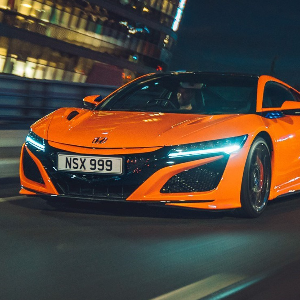
PROS:
+ Quick
+ Looks great inside and out
+ Electric range enough for most commutes
CONS:
- Expensive
- Indecisive gearbox
- Electric motors not very refined
Verdict: There’s a lot to love about the 508 PSE – mainly its standout styling and willing chassis – but at £54,000 it’s too expensive for a Peugeot, even a fast one. There are more refined hybrids in the class too.
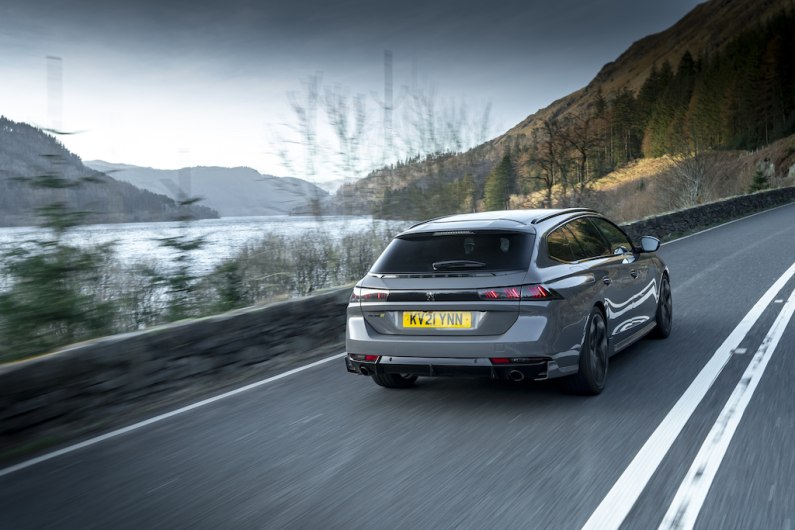
2021 Peugeot 508 PSE: the five minute read
You might be wondering what the letters ‘PSE’ stand for. They stand for Peugeot Sport Engineered, and this is the first car from the newly formed division that will take care of Peugeot’s more exciting stuff from now on, as well as its return to Le Mans in 2022.
Unlike fast Peugeots of the past, such as the 208 GTI, all PSE models will use some form of electrification to harness hot performance. As such, the 508 PSE is a complex mix of combustion engine, modest battery and two electric motors. It’s the fastest production car Peugeot has ever made and it comes in both saloon and estate variants.
Rivals? That’s not an easy question to answer either. Peugeot itself cites the BMW 340i as the enemy, and in terms of rapid plug-in hybrids you would have to say the V60 T6 Recharge offers a compelling argument against the 508 PSE, offering similar performance at a cheaper price.
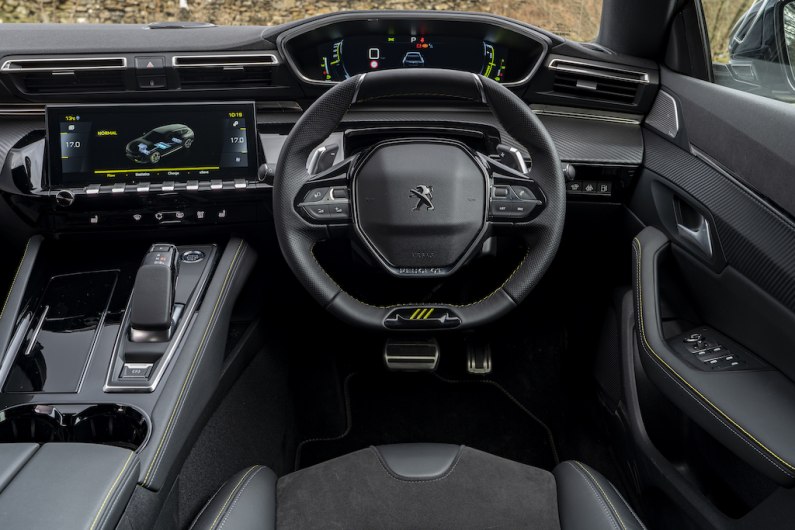
It only takes a casual glance to realise this is not your standard 508. It’s wider at the front and back and comes peppered with PSE-specific design cues, such as the luminous green panels and ‘lion’s claw’ slashes on the bonnet and boot. It’s a handsome thing, and it gets plenty of attention from other drivers.
Peugeot’s interior game is on-point at the moment and it’s no different with the 508 PSE, which stands out from the regular model with some carbon fibre-effect trim on the dash and more splashes of that green. The piano key shortcut buttons are handy but also look great, as does the Peugeot’s signature small steering wheel.
The infotainment system is a good size at 10-inches and it’s mated to a 12.3-inch digital driver display. It boasts some bespoke graphics to show how power is being used in the different drive modes and it all looks pretty good, but the system itself can be frustratingly slow to respond. Both Volvo and BMW’s system is better.
Despite the fact Peugeot has had to shoehorn in a bulky 11.5kWh battery, cabin and boot space is not compromised. There’s a good amount of legroom in the back seats, although headroom might be a little tight for taller passengers. The saloon offers 487-litres of boot space and the estate 530-litres, which is on a par with the BMW 340i and Volvo V60.
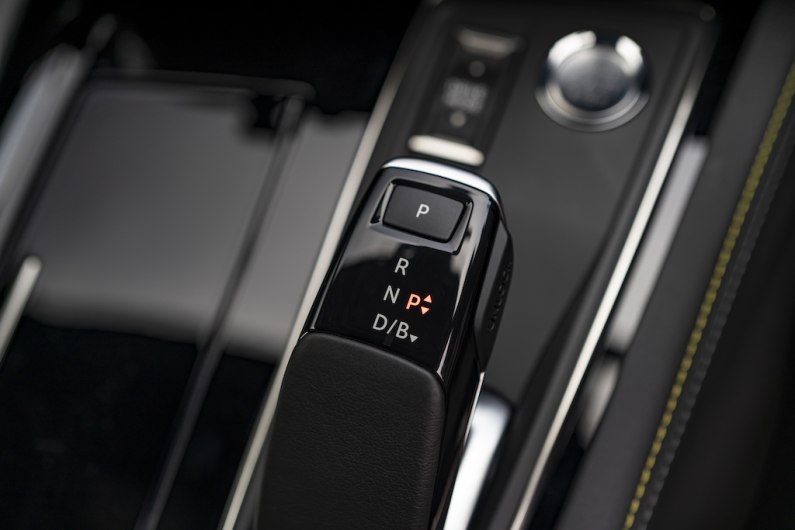
It’s the engine which is the complicated bit. Powering the 508 PSE is a 1.6-litre turbocharged petrol engine producing 197bhp. It’s complemented by two electric motors, one on each axle. At the front the motor knocks out 108bhp while the rear motor is good for 111bhp. Total output, however, is limited to 355bhp and 520Nm of torque when all things are working together.
Looking at the output figures you might expect the 508 PSE to be a bit quicker from 0-62mph than its time of 5.2-seconds. It is brisk, no doubt, but it’s bang-on with the Volvo V60 T6 which is around £10K cheaper, and it’s not quite as rapid as the BMW 340i or Audi S4, which both dip under the five second mark.
That said, with all-wheel drive and a rigid chassis it’s very stable and willing when attacking corners, and you can feel the rear motor helping to push the nose around the apex. The only problem is an indecisive eight-speed automatic box and a slight lag between the low-end shove of the electric motors and the petrol engine jumping in.
The 508 PSE is a very likeable car, but it’s far from the best in it class in terms of outright performance or electric range, which is a claimed 26-miles. If it was £10,000 cheaper that would be more forgivable, but it’s hard to see why you would spend £54,000-plus on one when both the BMW 340i and Volvo V60 offer more at a cheaper price.
Unless, of course, standing out on the road is important to you. Because you’ll certainly do that.
For great Peugeot 508 deals click here
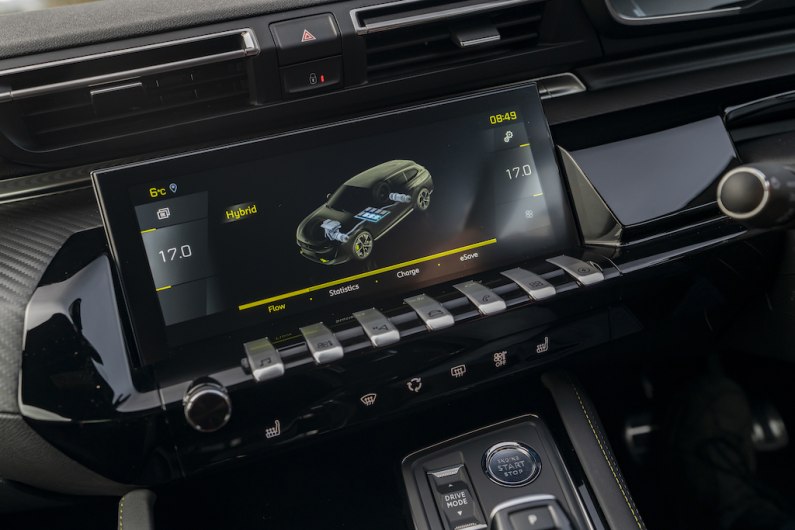
Extended read…
2021 Peugeot 508 PSE interior and infotainment
The standard 508 is no slouch when it comes to the interior and with the extra splashes of finesse for this PSE version it adds up to a very nice cabin indeed. Those splashes include green stitching on the seat upholstery and steering wheel, and elsewhere there’s plenty of soft-touch plastic.
The dashboard is slashed by a panel of carbon fibre-effect trim which adds to the sporty feel of the supportive seats and small steering wheel, and the centre console controls are housed in expensive looking black gloss. Above them sit the piano key buttons which are a slick touch, but they’re also found in the regular 508.
The build quality feels good enough but you would feel more confident in something from BMW in terms of durability, it doesn’t feel quite as well screwed together.
The infotainment system benefits from a big screen which is within easy reach of the driver, and those piano key buttons serve as shortcuts so getting around the system isn’t difficult. Some things feel unnecessarily fussy though: it takes four inputs to turn the battery charging up to maximum, which should really be done at the push of a button.
The screen’s graphics are sharp and there is plenty included, such as DAB, sat nav, 360-degree camera and Apple CarPlay and Android Auto. The let-down is the response time – you sometimes need to press a button twice to get it to do its thing, and it is prone to the odd glitch.
Wireless phone charging comes as standard, as does a premium sound system from Focal which sounds great.
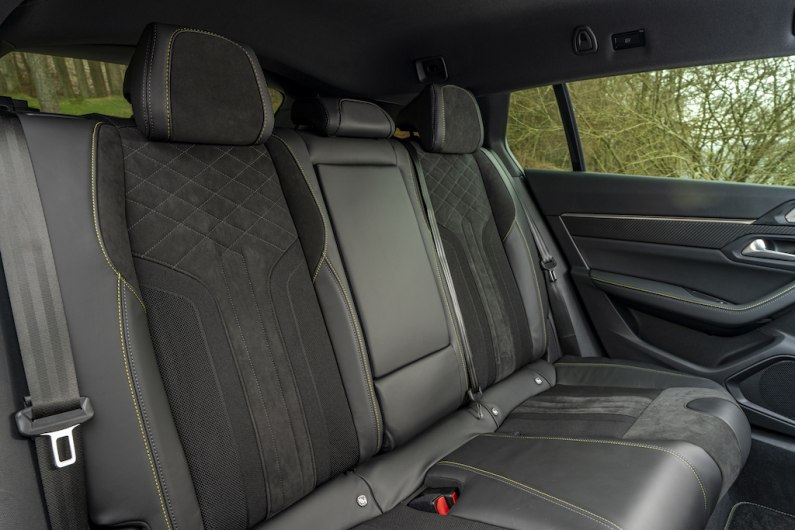
2021 Peugeot 508 PSE practicality and boot space
Storage in the front of the cabin leaves a little to be desired – the door bins are small and so is the glove box. A fold-down armrest with cup holders helps things in the back seats but, again, the door bins are small. The front seats do have storage pouches on the back though.
Leg and head room shouldn’t be an issue, except for only very tall passengers. The 508 SW (estate) has a raked roofline which slightly eats into overhead space. The front of the cabin is spacious and the seats have a good range of movement, and they are very supportive, so you’ll be comfortable on long journeys.
It should go without saying the SW model is better equipped for those who need to lug a lot of stuff, with a decent-sized 530-litre boot. The saloon offers 487-litres with the seats up, which rises to 1,537-litres when they’re folded down. That makes it one of the roomier cars in the small saloon class, beating that of the Volvo S60 and the Mercedes-Benz C-Class.
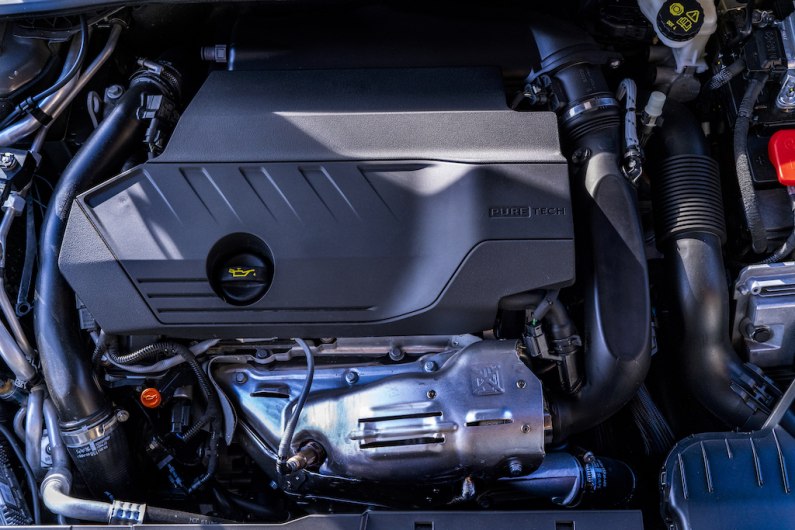
2021 Peugeot 508 PSE engine
Powering the 508 PSE is a 1.6-litre turbocharged petrol engine producing 197bhp. It’s complimented by two electric motors, one on each axle. At the front the motor knocks out 108bhp while the rear motor is good for 111bhp. Total output, however, is limited to 355bhp and 520Nm of torque when all things are working together.
The 0-62mph sprint is done in a fast-but-not-furious 5.2-seconds and the top speed is limited to 155mph.
Powering the electric motors is a 11.5kWh battery which can, Peugeot claims, cover 26-miles of petrol-free driving. The best we go out of our test car was 18-miles, but that’s still more than the average daily commute.
At 26-miles the range is lower than that of the Volvo V60 T6 Recharge or the BMW 330e.
Using a 7kW wall box or charging point the battery can be recharged fully in about one hour 45 minutes, but it will take much longer on a standard plug. The engine can charge the battery but doing that drinks the petrol, so it feels like a false economy. You have to make a choice: do you want your fuel to drop or electric range to drop?
The 508 PSE comes as standard with AWD and an eight-speed automatic gearbox with paddle shift.
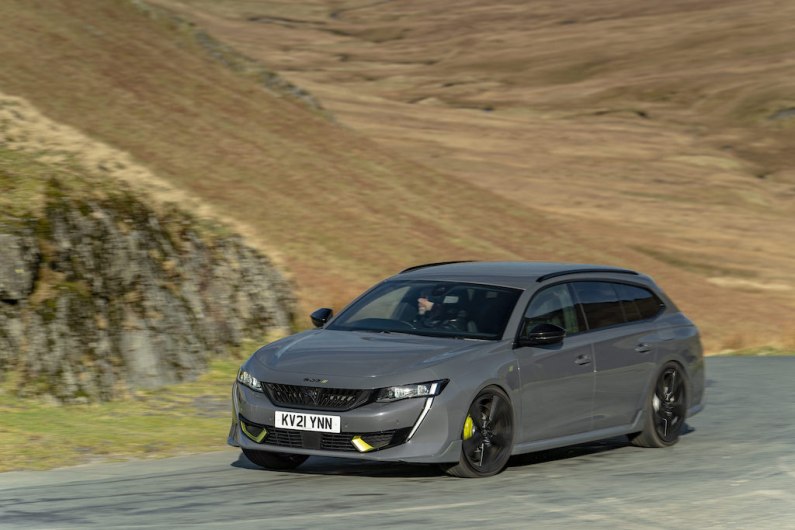
2021 Peugeot 508 PSE driving
The 508 PSE has a confusing number of drive modes, but that’s no different to hybrids from brands like Volvo. Hybrid Mode is for day-to-day driving which uses the electric motors when appropriate - at speeds of up to 80mph - and brings in the petrol engine when needed.
All-wheel drive mode ensures both axles are powered at all times and is a great comfort when things get wet or icy on the road. Comfort mode is the same a hybrid mode but softens the ride via the adaptive dampers. Finally, sport mode is full on attack and unleashes the full 355bhp.
Starting with the good, the 508 PSE holds the road very well. It has a rigid chassis which allows for rapid changes in direction, and while the steering isn’t endowed with much in the way of feel it’s responsive and obedient. That coupled with the driven rear axle means it buries itself into an apex and then out again in a way most saloons and estate won’t.
That said, it’s not as precise as the BMW 340i, but it is certainly more engaging than the Volvo V60 or Audi S4.
Power arrives early and urgently thanks to the electric motor but there’s a slight disconnect between the motors and the petrol engine, it’s not as seamless as you want it to be and it interrupts the acceleration process. Similarly, the automatic gearbox can be slow to drop a cog and get going, although using the paddle shift negates this problem.
The ride is always on the firm side, even in Comfort Mode, but that probably has as much to do with the fact the car rides on 20-inch wheels as it does with the damping set up. Plus this is supposed to be a sporty car, so firm damping is to be expected.
The problem is, with a modest electric range compared to its hybrid rivals and less power and handling prowess than its combustion engine rivals the 508 PSE isn’t the best at anything, it’s just decent at everything. For the price you want either more refinement or more power - or both.
